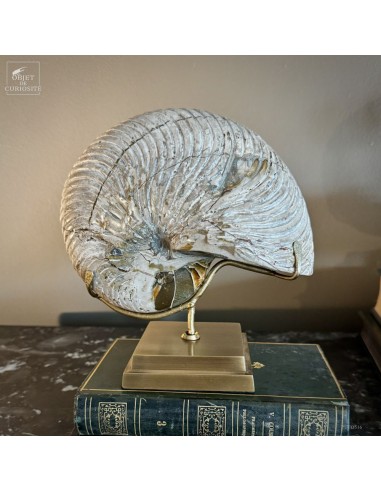- New
CYMATOCERAS sakavalus ammonite – Cenomanien, Madagascar
PUFO516
This ammonite Cymatoceras Sakavalus comes from the north-eastern coasts of Madagascar, where marine deposits from the Upper Cretaceous have produced some of the finest known collection fossils. Dating from about 100 million years ago, it testifies to the biological richness of the tropical seas of the Cenomanian, a period marked by the greatest depth ever reached by the sea.
The genus Cymatoceras is recognized by its massive and strongly ribbed shell. It is a nautiloid shape, approaching its current descendant: the nautiles.. These reliefs are typical of Cymatoceras sakavalus, and the fossilisation process here has preserved surprisingly precise details, such as the layer of mother-of-pearl that this shell had more than 100 million years ago, in the Cenomanian. The surface of the mother-of-pearl has been very slightly polished to regain the shine it had then, and this allows one to see an "opalinisation": a red sheen where the shell is missing -picture 3-
Presented on a brass base, this natural curiosity illustrates the beauty and perfection of the prehistoric marine world.
The genus Cymatoceras is recognized by its massive and strongly ribbed shell. It is a nautiloid shape, approaching its current descendant: the nautiles.. These reliefs are typical of Cymatoceras sakavalus, and the fossilisation process here has preserved surprisingly precise details, such as the layer of mother-of-pearl that this shell had more than 100 million years ago, in the Cenomanian. The surface of the mother-of-pearl has been very slightly polished to regain the shine it had then, and this allows one to see an "opalinisation": a red sheen where the shell is missing -picture 3-
Presented on a brass base, this natural curiosity illustrates the beauty and perfection of the prehistoric marine world.
















